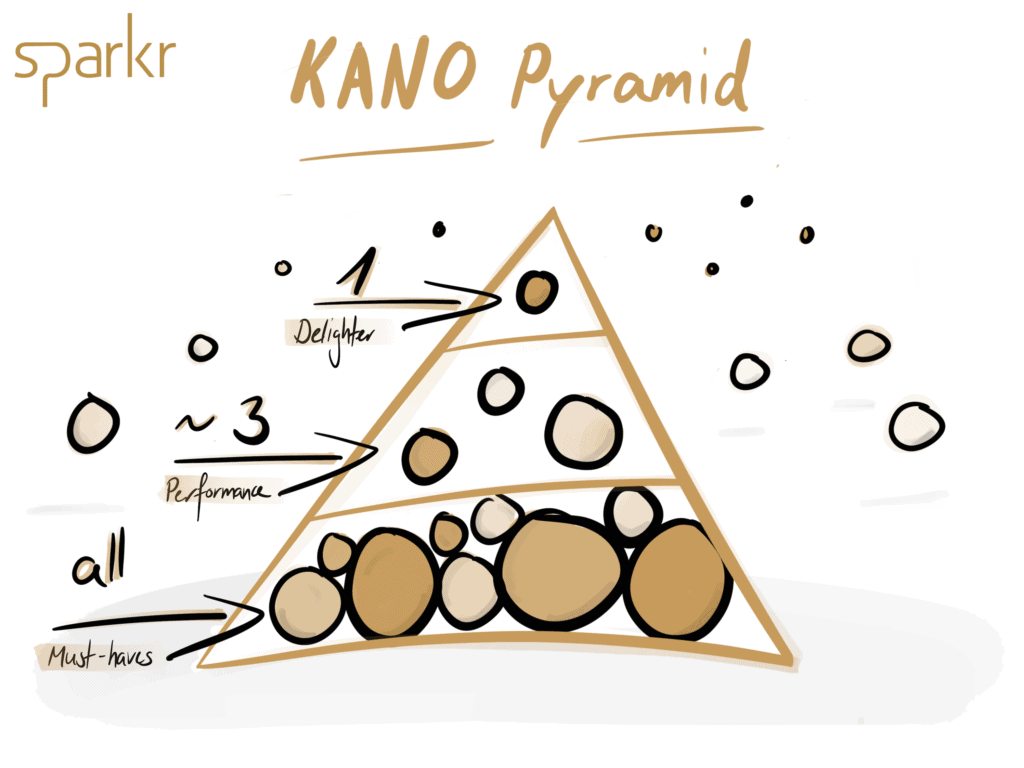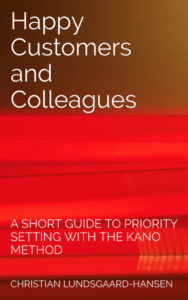This extensive blog post is also available as a compact ebook on Amazon. Feel free to check it out and leave a rating on Amazon if you liked this post.
***
The KANO method helps us to create delightful experiences and be successful with our limited resources with three simple steps. Let's jump right in.
We've all been in these situations where we want to achieve an outstanding result with limited resources of time, money or energy. The examples are manifold:
- We want to develop new, innovative products, but we have to use our limited resources proficiently on the way to innovation.
- We lead teams and want to motivate them persistently - but how?
- We want to build good, long-lasting client relationships but must devote our time primarily to important daily business.
In all these examples, we are dealing with a situation where we have to prioritise in order to achieve the desired success. Let's ask KANO for help.
KANO customer experience satisfaction
Dieser Artikel ist auch auf Deutsch als PDF zum Download verfügbar
Wenn Sie diesen Artikel auf Deutsch gerne jederzeit verfügbar haben möchten, können Sie ihn ganz einfach als PDF herunterladen.
KANO model priority setting prioritization
The KANO model
This is where KANO comes in. The KANO model was developed by the Japanese professor Noriaki Kano, who wanted to systematise various customer requirements in product development with his model. In my opinion, however, his model offers clues and inspiration for the development and design of a wide variety of things: from products to relationships to personal lifestyles. Because practically everywhere, as already explained, it is about creating pleasant or even delightful experiences with limited resources.
What does the KANO model have to offer? Let's start with the original application of the model in product development. Every product consists of different features and functions. The first step of KANO is to categorise these features and functions. According to KANO, there are five categories of features (numbers correlate to the graphic below):
- Must-haves: Features that are expected by customers. These can be considered must-haves and absolutely basic characteristics. Because they are taken for granted, these features will not arouse enthusiasm, but may very well cause a lot of damage if they are poorly implemented or completely absent.
- Performance features: Characteristics with which products mainly compete with each other. Customers consciously look for these features and their performance is important for satisfaction. As a rule, the more of these attributes or the better their implementation, the better the perceived performance of the product and the higher the satisfaction.
- Anti-performance: These features are related to the above mentioned performance features, but behave in exactly the opposite way. So: the more these characteristics are present, the worse for the product and the satisfaction.
- Indifference: These are features that the customer does not care about. Their presence or absence has no positive or negative influence on the customer experience.
- Delighters and exciters: Features that are not expected by the customer, but whose (surprising) presence cause enthusiasm.
All-in-one chart
Before we dive into a few examples, let's take a look at these five categories graphically. To do this, we create a coordinate system with two axes. The horizontal axis provides information on the extent to which a feature is or is not present or how well it is implemented. The second, vertical axis describes the level of satisfaction and enthusiasm that is achieved for the customer by the feature.

KANO customer satisfaction
Welcome to the KANO hotel
To familiarise ourselves with this graphic and to practise using the KANO model, let's imagine a visit to a hotel.
After a long journey, we arrive at our hotel room and look forward to a refreshing shower. Under the shower, we realise that the hotel room unfortunately has no running water right now due to construction work. That is an absolute no-go! Running water is a basic must-have feature of a hotel room. If this feature is absent, it greatly worsens the customer experience, while even the most excellent implementation of running water would provoke a neutral shrug of the shoulders from the customer at best, because this feature is expected and considered basic.
After this first bad experience, we want to calm down a bit and go to the balcony to get some fresh air. There we enjoy the beautiful view. We knew that we would have a balcony in this room and are very happy with this (expected) feature of our room. We even find the view much better than in many hotels we have stayed in before. So, compared to other hotels we like this performance very much and recognize it as a nice plus over the competition. However, the beautiful view has no chance to compensate for the defective shower. But in itself we are very satisfied with this feature of our room.
We are also pleased by the fact that we enjoy absolute peace and quiet on the balcony and are not disturbed by street noise. The absence of noise (an anti-performance feature) is an important recreational factor for us. So, the absence of noise is another plus for us.
Now we lie down on the bed for a moment and notice the television on the opposite wall. It has a diagonal of about 47 cm - which we don't really care about. Whether the diagonal is 30cm or 70cm is irrelevant to us. After all, we didn't come to this hotel to have a great TV experience. The complete absence of a TV might be irritating, but we are indifferent about the diagonal of the screen.
Lying on the bed, we notice a small brochure on the side table. In it we read that we can choose from a whole menu of different types of pillows and can order the best pillow for us at no extra charge at the reception and it will be delivered to our room. This pleasant surprise causes delight because our fictitious hotel guest has been struggling with neck problems for a long time and often spends unrestful nights in hotels because the normal pillows never meet his needs. So this surprising choice of different pillows causes spontaneous delight for the customer.
It's all in the mix
Let’s recap: Every experience (like our hotel stay) and every product is a collection and a specific constellation of the different feature categories. Each provider chooses a different mix and can thus differentiate itself.
But we can also look at it the other way round and realise that different customer segments and target groups classify the features differently - what is a performance feature for one target group does not matter to another and so on. In other words, the mix of characteristics makes the difference between whether an experience will be satisfying for a particular target group or not. KANO can therefore be useful in developing a product-market fit.
What is your personal mix and how has it changed over time? If you want, you can go through the world in the coming days with a playful curiosity and look at things through a pair of KANO glasses. This will help you to recognise what is important to you, what delights you personally and what leaves you unimpressed and indifferent.
You can also think back to earlier times and realise that your favourite mix of features has changed over time. What once excited you may have become a must-have.
For providers of experiences and products, it is therefore important to note that the "right mix" depends on the target group, is constantly in motion and therefore the offer must move and adjust accordingly. Recurring enthusiasm and success has to be earned. Resting on your laurels and standing still for too long is not an option.
Is KANO everywhere?
I think after this test run using the hotel example, we can become a bit more virtuosic and ask ourselves how else we can use the KANO model. Could it be that this KANO method could offer interesting clues in all kinds of situations? Can it help us setting the right priorities and invest our resources wisely? How about the client relationships mentioned at the beginning that we want to improve or the strengthening of our team spirit?
No matter which example we choose, we need to ask ourselves the following questions according to the KANO model:
- What are the absolutely elementary basic qualities that must be fulfilled? Here we have to identify and fulfil all of them.
- Which features improve performance and satisfaction (for the client, for our team members, etc.) and which 2-3 features do we want to focus on? Which ones add the most value - i.e. have the best return on investment? Which mix of features is particularly interesting and potent? After all, we always have to arrange ourselves with limited resources and therefore, realistically speaking, we cannot provide all performance features at the same time.
- Which things do we have to avoid and which characteristics can we safely disregard?
- How can we delight and excite people? Which small things can trigger disproportionate surges of satisfaction - i.e. have an extraordinarily high return on investment?
In my opinion, as a rule of thumb we can imagine a successful product, service etc. as a pyramid: The foundation is formed by the must-have qualities. Here we need to be thorough and conscientious. The next level belongs to the performance features, where we want to get an attractive mix of a few of these attributes and execute excellently. At the top of the pyramid are the delighters and exciters, where we can create a long-lasting wow effect with just one of these features.
Note that we could try and pack as many features in our KANO pyramid as possible. But we won't. If we need to prioritise, we should make sure that we have all the must-have features covered, include a couple high-performance features (not all of them since we need to take our limited resources into account) and top it all of with at least one delighter.

Dieser Artikel ist auch auf Deutsch als PDF zum Download verfügbar
Wenn Ihnen diese Zusammenstellung nützlich erscheint und Sie diesen Artikel gerne jederzeit verfügbar haben möchten, können Sie ihn ganz einfach als PDF herunterladen.
The KANO method applied in client relations
If we want to take our client relationships to the next level, this could mean that we do everything we can to deliver our work to the client on time and in a satisfactory manner; in this example, these would be the fundamental must-haves that we want to fulfil conscientiously. As a performance feature, we might want to be known for always going the extra mile in the interest of the client without being asked to do so. This would allow us to really understand the client's needs in depth and therefore be able to repeatedly make accurate and valuable suggestions that will make the client even more successful thanks our extra effort. And finally, we may cause outstanding delight by giving the client two tickets to the concert of his favourite band as a surprise for his birthday. This surprise was made possible because we noticed during the Zoom call in the background that the client has a large record collection from this group. (Admittedly, this last example only works once the pandemic has passed and we can go to concerts again. But you will certainly find other examples of wow effects).
Smells like team spirit
As KANO rockstars, we can now venture into the thought experiment of how we could also use the method from product development to create satisfaction and enthusiasm among our team members.
So once again we approach the topic with the 3 central KANO steps:
- What is absolutely central, fundamental and imperative for a good foundation?
- With which +/- 3 measures can we increase satisfaction (and performance) and raise it from the foundation to the next level?
- How can we create a moment of delight, excitement or enthusiasm every once in a while?
Of course, we all have to answer these questions in our own way or transfer them to our own contexts. But let's continue with the thought experiment.
We could start with fundamental core values like mutual respect, reliability, sincerity and so on. Of course, when it comes to these basic values, it is worthwhile not only to rely on your own values and assumptions, but to take enough time at this point and have some personal conversations with the employees to test your assumptions. If we miss the mark here or miss something important, we lose a lot and build on a weak foundation.
There are several performance characteristics that raise the motivation level from neutral to good. We won’t stand a chance to implement all of them, but there are certainly a few things related to each specific team that can make a significant difference. Maybe the weekly team meeting should be structured differently? Maybe there's a piece of (antiquated) company policy that should be removed or changed? Maybe each team member should invest in their own lifelong learning during work hours and with financial support from the employer to be able to contribute to a successful team in the future and grow as a person? Maybe the team needs a culture where no one has to be afraid of making mistakes? Whatever the right choice of the most important performance characteristics will be in a specific case, it is also advised here that through exchange with colleagues one can build up a constructive idea for the right performance mix.
Last but not least come the wow factors. We remember the graphic according to which even a little bit of these enthusiasm characteristics can trigger a real surge of satisfaction. As a team leader, why not send a surprise after-work package to all employees working remotely with a fine beer or wine and some tasty snacks and a handwritten note with the message that after a successful week, the team should clock out early on Friday afternoon for the well-deserved weekend? Such surprising delighters can work wonders and have a positive effect for weeks - not bad for an activity for which we have invested roughly half a day. But beware: if the foundation of the pyramid as well as the performance level are not solid, even such a pleasant delighter will quickly fizzle out.
KANO in three words: fulfil, convince, excite
It is such moments of enthusiasm and a solid foundation that allow us to take off - be it with our new product or with our clients or employees. The KANO model teaches us that we have to fulfil the basic things as well as convince with excellent work in selected areas and should excite people with a delightful surprise every now and then.
So the next time we find ourselves in a situation where we want to achieve a remarkable result with limited resources, let's remember the KANO pyramid: we should divide our resources in such a way that we can fulfil all the fundamental qualities, convince in a few important performance areas and excite with at least one feature. With this KANO-inspired method, we prioritise in an effective way and build the foundation for sustainable, recurring success. What fundamental qualities do you want to fulfil? How do you want to convince? And how do you want to excite? Have fun with your personal exploration of KANO.
Dieser Artikel ist auch auf Deutsch als PDF zum Download verfügbar
Wenn Ihnen diese Zusammenstellung gedient hat und Sie diesen Artikel gerne jederzeit verfügbar haben möchten, können Sie ihn ganz einfach als PDF herunterladen.
KANO model method customer satisfaction needs UX prioritizing
Recommended reading
Sparkr offers many inspirations for leaders and executives. We hope to add value by sharing experiences and insights from experts compiled and remixed just for you. Here are a few topics that might be of interest to you:
- Self-management methods and productivity tips for a hectic work and private life.
- Strengthen your resilience with 9 insights from stress research.
- And much more on the Sparkr Blog.
More Episodes of the Sparkr Podcast
You find all the Sparkr Podcast Episodes here and you can subscribe to the podcast on Apple Podcast, Spotify, Soundcloud or wherever you listen to your favorite shows.
You can also join the group of Newsletter recipients and receive carefully selected stories form the world of tech and innovation every couple of months. No BS or noise.
#17 Sustainability - Insights from a fascinating researcher and social entrepreneur (English)
#15 Resilienz und Widerstandskraft stärken mit Erkenntnissen aus der Stressforschung (text: English, audio: German)
#14 The Future of Work and Open Innovation - a Conversation with Stanford Professor Pamela Hinds (English)
#12 Künstliche Intelligenz und die Folgen für Mensch, Gesellschaft und Wirtschaft mit Thomas Ramge (text: English, audio: German)
#11 Jean-Claude Biver über wahren Erfolg, echten Luxus und was wir von Hippies lernen können (Deutsch)
#10 Executive Briefing on 5G (English)
#3 Lukas Peter from Swisscom about what (Swiss) SME can learn from Silicon Valley (text: English, audio: German)
#2 Timo Pelz from Facebook about the importance of corporate culture (English)
#1 Ottmar Hitzfeld about leadership (German)






